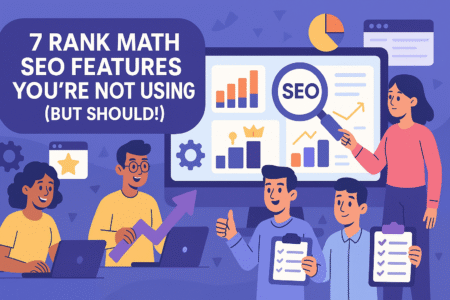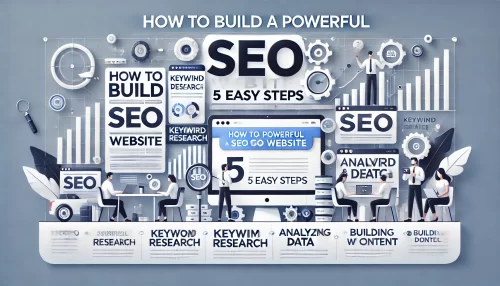Table of Contents
Are you struggling to boost your website’s organic rankings and sustain them over time? Do you wonder how to create an effective SEO strategy that ensures long-term success?
This guide will break down the critical steps, practical tips, and proven techniques to help you build and maintain an effective SEO strategy.
Understanding the Core Elements of SEO Strategy
To succeed with SEO, understanding its foundational elements is essential. A robust strategy starts with knowing why SEO matters, setting clear goals, addressing search intent, and using analytics effectively to guide decisions.
Why SEO Strategy Is Crucial for Online Growth
SEO is the backbone of online visibility, ensuring your website appears to potential customers searching for what you offer. Without a strategy, businesses risk being overshadowed by competitors or failing to capture valuable traffic.
Developing a thoughtful SEO strategy allows businesses to align their digital presence with their audience’s needs. For instance, if users frequently search for “how to create an effective SEO strategy,” having optimized content for that query increases your chances of ranking high. This visibility attracts organic traffic, which is often more cost-effective than paid methods.
Moreover, an effective SEO strategy helps build authority over time. I believe consistently publishing valuable content and optimizing technical aspects signal to search engines that your site deserves to rank higher. Think of it as nurturing a long-term relationship with search engines and users alike.
In addition, SEO ensures scalability. While ads may work temporarily, an optimized site continually drives traffic without requiring constant spending. I suggest focusing on evergreen content that maintains relevance and delivers traffic for years.
Finally, SEO amplifies your marketing efforts. For example, integrating keywords with social media campaigns can strengthen brand recognition, driving more clicks and conversions.
Defining Long-Term Goals for Your SEO Strategy
Clear, achievable goals act as the roadmap for any SEO campaign. Without them, efforts can become scattered, making it harder to measure success or refine tactics.
Start by identifying what success looks like for your business. For some, it’s increased organic traffic; for others, it’s higher conversion rates. I recommend aligning these goals with broader business objectives. For example, if you’re a retailer, an SEO goal might include ranking for “affordable online shopping” to attract budget-conscious buyers.
Long-term goals also require patience and consistency. I often advise focusing on measurable metrics, such as domain authority or keyword rankings, to track progress. These metrics offer a snapshot of how your strategy is evolving.
Break these larger goals into smaller milestones. For example, if your aim is to boost website traffic by 50%, begin with keyword research to identify high-potential phrases and gradually implement changes to content and technical SEO.
Finally, revisit your goals periodically. SEO trends change, and what worked a year ago may not be as effective today. By staying flexible and adjusting your goals, you ensure your strategy remains aligned with both industry changes and user behavior.
Understanding Search Intent to Improve SEO Results
Search intent is the “why” behind every query, and it holds the key to crafting content that resonates with your audience. Understanding this intent allows you to deliver the precise information users are looking for, improving both engagement and rankings.
There are typically three types of search intent: informational, navigational, and transactional. I suggest tailoring your content to match these intents. For instance, if users search “how to create an effective SEO strategy,” they’re likely seeking detailed guidance, not a product to buy.
Meeting search intent involves understanding your audience deeply. Conduct surveys or use tools like Google Analytics to discover common queries and preferences. For example, if data shows users value step-by-step tutorials, prioritize creating comprehensive guides.
Additionally, structure your content for easy scanning. Include headings that directly address user queries, such as “What Is SEO?” or “Tips for Long-Term Success.” This approach not only satisfies search intent but also encourages longer dwell times—a factor that can boost rankings.
I recommend reviewing search engine results for target keywords to assess competitor content. Notice what ranks at the top: are they blogs, videos, or infographics? Use these insights to refine your strategy and deliver what users prefer.
Finally, don’t overlook the role of keywords. While satisfying search intent is the priority, weaving your focus keyword naturally into headings and text ensures search engines recognize your content’s relevance.
The Role of Analytics in Shaping SEO Tactics
Analytics are the compass that guides your SEO journey. They reveal what’s working, what isn’t, and where to invest your efforts for maximum ROI.
To start, tools like Monsterinsights and Search Console are invaluable. These platforms provide insights into traffic patterns, bounce rates, and click-through rates (CTR). For example, if a page optimized for “how to create an effective SEO strategy” has a low CTR, revising its meta description or title could improve performance.
I recommend setting up custom dashboards to track key metrics specific to your goals. For instance, if you’re aiming to boost mobile traffic, monitor mobile device metrics closely. These insights highlight areas where optimization is most needed.
Analytics also help you identify opportunities. Suppose you notice a high-ranking page receiving significant impressions but limited clicks. Adjusting the content or meta tags could bridge this gap and increase conversions.
Lastly, use analytics to evaluate your audience’s behavior. Tools like heatmaps reveal which parts of your site receive the most engagement, guiding your design and content decisions. I suggest leveraging this data to create user-centric experiences that improve SEO and customer satisfaction.
Analytics aren’t just about numbers—they’re about strategy. By integrating them into your decision-making process, you turn data into actionable insights that power long-term success.
Researching Keywords for Maximum Impact

Keyword research is the foundation of a successful SEO strategy. Identifying the right keywords ensures your content aligns with user intent and drives targeted traffic. This section explores methods to uncover impactful keywords that boost visibility and engagement.
Identifying High-Value Keywords for Your Niche
Targeting high-value keywords is essential for maximizing SEO results. These keywords are relevant to your audience, have a reasonable search volume, and offer lower competition for easier ranking.
Start by considering what your ideal audience searches for. I recommend brainstorming a list of topics related to your niche. For instance, if your business revolves around digital marketing, terms like “how to create an effective SEO strategy” might already be on your radar. These seed ideas serve as starting points for deeper keyword research.
Next, evaluate search volumes and competition using tools like Google Keyword Planner or SpyFu. High-value keywords strike a balance between search popularity and competition. For example, a keyword with 1,000 monthly searches and moderate competition might be more effective than a heavily competitive one with 10,000 searches.
I believe it’s important to prioritize keywords that align with your goals. If your focus is lead generation, target keywords that indicate purchasing intent, such as “best SEO tools for beginners.” Conversely, if awareness is your priority, opt for informational keywords.
Finally, use high-value keywords strategically throughout your content. From titles to meta descriptions, each placement should feel natural. Incorporating the keyword into headings and the opening paragraph signals relevance to both readers and search engines.
How to Use Long-Tail Keywords to Increase Traffic
Long-tail keywords are longer, more specific phrases that often have lower competition and higher conversion potential. They may not attract as much traffic as broad keywords, but their precision drives qualified leads.
For example, instead of targeting “SEO strategy,” a long-tail variation like “how to create an effective SEO strategy for startups” is more specific and aligns with user intent. I suggest including these long-tail phrases in blog posts, FAQs, and subheadings to capture niche audiences.
Long-tail keywords also improve voice search optimization. With the rise of AI assistants, users often phrase searches conversationally. A phrase like “What’s the best way to create a long-term SEO plan?” matches natural language patterns, giving you an edge in voice-driven results.
I recommend using tools like PeopleAlsoAsk or Ubersuggest to find long-tail keywords. These platforms generate queries based on your seed keyword, helping you identify untapped opportunities. For instance, you might discover “how to create an effective SEO strategy for eCommerce” has search potential you hadn’t considered.
Incorporate long-tail keywords where they make sense. For example, a subheading like “How to Create an Effective SEO Strategy for Small Businesses” not only serves user intent but also keeps your content focused. As long as you maintain quality and relevance, these keywords can significantly enhance your traffic.
Conducting Competitor Analysis for Keyword Insights
Competitor analysis is a powerful way to discover the keywords driving traffic to similar businesses. By analyzing their strategies, you can uncover gaps and opportunities to refine your approach.
Start by identifying your main competitors. These are businesses targeting the same audience or offering similar products. Tools like Ahrefs or SEMrush allow you to enter competitor domains and see their top-performing keywords. For instance, if a competitor ranks well for “how to create an effective SEO strategy,” it’s worth investigating their content.
I advise paying attention to keywords they’re ranking for but aren’t targeting effectively. If their blog post briefly touches on “SEO tips for startups,” you could create a comprehensive guide to outperform them. This strategy often leads to higher rankings for niche keywords.
Additionally, monitor the type of content competitors use for specific keywords. Are they using blogs, videos, or infographics? If a competitor dominates with video content, consider diversifying your approach to cater to audiences who prefer written guides.
Lastly, competitor analysis helps you spot emerging trends. If you notice competitors frequently targeting keywords related to AI-driven SEO, it may be a signal to explore that space in your content. Staying ahead ensures you maintain relevance in your niche.
Tools to Simplify Keyword Research and Prioritization
Keyword research tools simplify the process of finding and organizing keywords, saving time while ensuring accuracy. Leveraging these tools effectively can make a significant difference in your SEO results.
One of my go-to tools is Google Keyword Planner. It provides search volume data, competition levels, and keyword suggestions. For example, entering “how to create an effective SEO strategy” might return related phrases like “SEO strategy template” or “SEO planning steps.”
Another valuable tool is SEMrush, which not only identifies keywords but also analyzes your competitors’ strategies. I suggest using its Keyword Magic Tool to generate an extensive list of potential keywords, then filtering by metrics like difficulty and search volume.
For those seeking content ideas, AnswerThePublic is excellent for uncovering user questions and concerns. By typing in your focus keyword, you’ll receive dozens of related queries, such as “Why is an effective SEO strategy important?” These insights help tailor content to real user needs.
Don’t overlook the importance of organizing your research. Tools like Trello or spreadsheets help track keyword priority, target pages, and metrics. I recommend categorizing keywords by intent—informational, navigational, or transactional—to create a balanced strategy.
Lastly, refine your process over time. Regularly revisit your keyword list, using tools to identify new opportunities or assess underperforming terms. With consistent effort, keyword research becomes a streamlined part of your SEO workflow.
Crafting High-Quality Content for SEO Success
Creating high-quality content is at the heart of every effective SEO strategy. Engaging, informative, and well-optimized content not only attracts readers but also earns trust from search engines, ensuring sustainable rankings and long-term traffic growth.
How Content Quality Drives Long-Term SEO Results
High-quality content is the backbone of a successful SEO strategy. It resonates with readers, encourages engagement, and positions your website as an authority in your niche.
First, quality content captures your audience’s attention. For instance, if someone searches “how to create an effective SEO strategy,” they’re looking for clear, actionable advice. I suggest writing content that answers these queries directly while offering practical tips and examples. This keeps readers engaged and increases their time on your site—an essential ranking factor.
Next, high-quality content builds backlinks naturally. Websites are more likely to reference well-researched, valuable content. For example, an in-depth guide on SEO strategy could attract backlinks from industry blogs, boosting your domain authority.
I believe content quality also impacts shareability. Informative or emotionally resonant content is often shared across social media platforms, extending its reach. Adding shareable elements like infographics or videos can amplify these effects and drive additional traffic.
Finally, search engines favor high-quality content because it aligns with user intent. By addressing specific needs or solving problems, your site signals its relevance. Over time, this translates to sustained rankings and better visibility for competitive keywords.
Optimizing Content With Focus Keywords and LSI Terms
Keyword optimization is essential to ensure your content aligns with user intent and ranks for relevant searches. Combining focus keywords with Latent Semantic Indexing (LSI) terms enhances relevance and boosts search engine visibility.
Start by incorporating your primary keyword naturally throughout the content. For instance, if the keyword is “how to create an effective SEO strategy,” include it in the title, introductory paragraph, and a few subheadings. I advise avoiding overuse, as keyword stuffing can harm your rankings.
LSI terms, or related keywords, enrich your content by providing context. Tools like Google’s “People Also Ask” section or platforms like SEMrush can help identify LSI terms. For example, related phrases like “SEO planning,” “content optimization,” or “SEO implementation tips” complement your primary keyword and diversify your content.
I recommend using keywords strategically in metadata. Titles, meta descriptions, and alt text for images are prime locations. For instance, an alt text reading “A detailed guide on how to create an effective SEO strategy” not only helps search engines but also enhances accessibility.
Finally, review your content’s flow after optimization. Ensure keywords and LSI terms fit seamlessly into sentences. Clunky phrasing or forced inclusion can deter readers. I believe readability should always take precedence over rigid keyword placement.
Creating Evergreen Content for Sustainable Rankings
Evergreen content remains relevant and valuable long after it’s published. This type of content attracts consistent traffic, making it a vital component of any long-term SEO strategy.
Start by identifying topics with lasting appeal. Guides, how-tos, and lists are excellent formats for evergreen content. For instance, a post titled “Top Tips for Creating an Effective SEO Strategy” remains useful regardless of industry changes.
Focus on timeless advice. While it’s tempting to chase trends, I suggest incorporating broader insights that apply universally. For example, principles like “prioritize user experience” or “focus on quality backlinks” hold relevance across SEO strategies.
Updating evergreen content periodically ensures its continued relevance. For example, a guide on SEO strategy might need updates to reflect algorithm changes or new tools. Regular refreshes signal to search engines that your content is maintained and trustworthy.
Lastly, invest in high-quality visuals to complement your evergreen content. Infographics, diagrams, or videos can elevate the content’s appeal and increase its shareability, extending its lifespan even further.
Importance of Regular Content Updates for SEO
Consistently updating your content keeps it relevant, improves rankings, and enhances user experience. It’s a proactive way to maintain the effectiveness of your SEO strategy.
First, updating content shows search engines that your site is active. I recommend revisiting older posts to ensure accuracy, relevance, and freshness. For instance, if you wrote a guide on “how to create an effective SEO strategy” in 2020, updating it with recent trends and examples keeps it useful to readers.
Regular updates also allow you to target new keywords. As search trends evolve, you might find opportunities to include emerging phrases or refine existing content. For example, incorporating new keywords like “AI-powered SEO tools” into your content helps capture traffic from rising trends.
I believe user feedback is invaluable when updating content. Comments, email responses, or analytics data often highlight areas for improvement. For instance, if readers frequently ask for examples in a blog post, adding case studies or actionable tips can enhance its value.
Lastly, ensure technical optimization during updates. I suggest checking internal links, images, and page speed to ensure everything runs smoothly. Addressing these aspects alongside content updates creates a seamless user experience, reinforcing your site’s authority.
Optimizing On-Page Elements for Better Rankings

On-page SEO involves fine-tuning elements within your website to improve visibility and rankings. From titles and headings to internal links and URLs, optimizing these factors ensures your content appeals to both users and search engines.
How to Optimize Titles, Meta Tags, and Descriptions
Optimizing titles, meta tags, and descriptions is essential for signaling your content’s relevance to search engines while enticing users to click.
Start with the title. I recommend including your primary keyword naturally, like in my case “How to Create an Effective SEO Strategy: A Complete Guide.” Make sure your title is concise, descriptive, and under 60 characters to prevent truncation on search results. Titles that convey value—like using power words such as “Ultimate” or “Proven”—can boost click-through rates (CTR).
Meta descriptions are another critical element. They summarize your page in 150–160 characters and should also incorporate the keyword naturally. For instance, “Learn how to create an effective SEO strategy with actionable tips for long-term success” is concise, keyword-rich, and engaging.
Meta tags like header tags (H1, H2) and image alt attributes also play a role. I suggest using them to clarify the content structure and provide additional context to search engines. For example, an H2 titled “Why SEO Strategy Matters” makes the content scannable and user-friendly while signaling relevance to algorithms.
Finally, remember to personalize these elements for your audience. Avoid generic titles and descriptions. Instead, I advise addressing user intent directly, offering solutions to their problems, or piquing their curiosity.
Structuring Headings to Align With SEO Best Practices
Headings structure your content, improving readability and helping search engines understand its hierarchy. Effective use of headings not only enhances user experience but also boosts your SEO efforts.
Start by using H1 for your main title and subsequent headings in descending order of importance (H2, H3, etc.). I recommend making your H2s descriptive and keyword-focused, like “Optimizing On-Page Elements for Better Rankings.” This ensures users and search engines immediately grasp the content’s purpose.
Headings should also guide users through the content. For instance, under the H2 “Optimizing On-Page Elements,” subheadings like “Improving Internal Linking” or “Tips for URL Optimization” provide a roadmap. This structure makes your content digestible, reducing bounce rates.
I believe it’s essential to strike a balance between SEO and readability. Avoid stuffing keywords into headings. Instead, use related terms or synonyms to maintain flow and relevance. For example, “How to Structure Content for SEO” can complement “Optimizing Headings.”
Lastly, headings are an opportunity to answer user queries directly. Tools like Google’s “People Also Ask” section can inspire subheading ideas. For instance, if users often search “Why are headings important for SEO?” creating a subheading around this question directly addresses their intent.
Improving Internal Linking to Strengthen SEO Value
Internal linking connects pages within your website, helping users navigate your site while distributing link equity. This practice not only boosts SEO but also improves user engagement and retention.
Start by identifying key pages that need visibility, such as cornerstone content or high-converting product pages. I suggest linking to these pages strategically from related content. For instance, if you’re writing about “how to create an effective SEO strategy,” you could link to another article on “Top SEO Tools for Beginners.”
Anchor text is crucial in internal linking. Use descriptive and keyword-rich phrases that align with the target page’s content. For example, instead of generic terms like “click here,” use phrases like “learn how to optimize on-page elements.” This approach improves both usability and SEO relevance.
I advise monitoring your internal linking structure regularly. Tools like Screaming Frog or Ahrefs can identify orphan pages (pages with no internal links) or broken links. Addressing these issues ensures your site’s architecture remains robust and user-friendly.
Finally, keep the user journey in mind. Links should feel natural and provide additional value. Overloading pages with links can confuse readers, so I recommend prioritizing quality over quantity. Aim for 2–3 internal links per 1,000 words as a general guideline.
Tips for URL Optimization and Readability
A well-optimized URL is short, descriptive, and easy to read. URLs play a crucial role in signaling page relevance to search engines and creating a seamless user experience.
Start by keeping your URLs simple and keyword-focused. For example, instead of “example.com/post1234,” use “example.com/how-to-create-seo-strategy.” I recommend placing the primary keyword early in the URL for better visibility and search relevance.
Avoid unnecessary words or characters. I believe trimming filler words like “and,” “the,” or “of” helps streamline URLs. Additionally, use hyphens to separate words, as they are easier for search engines and users to read. For instance, “example.com/seo-tips-for-2024” is more effective than “example.com/seo_tips_for_2024.”
Canonicalization is another important aspect. If your site has duplicate content, specify the canonical URL to guide search engines to the preferred version. This practice prevents keyword cannibalization and ensures all ranking signals are directed to the correct page.
Lastly, ensure URLs align with the content. I suggest revisiting old URLs periodically, especially if they no longer reflect the page’s purpose. Updating these to match the content improves both SEO and user trust.
By optimizing URLs thoughtfully, you enhance navigation, improve search rankings, and create a more polished experience for your audience.
Leveraging Technical SEO for Long-Term Benefits
Technical SEO ensures that your website’s infrastructure is optimized for search engines and users alike. By focusing on elements like speed, mobile-friendliness, schema markup, and crawlability, you create a strong foundation for long-term SEO success.
Enhancing Website Speed to Improve SEO Performance
Website speed directly impacts user experience and SEO rankings. Faster-loading sites keep users engaged and send positive signals to search engines, making it an essential component of any technical SEO strategy.
First, website speed affects user retention. Studies show that users abandon pages that take more than three seconds to load. I suggest using tools like Google PageSpeed Insights or GTmetrix to identify areas slowing down your site. For example, compressing large images can significantly reduce load times without compromising quality.
Optimizing server response time is another crucial step. I recommend switching to a reliable hosting provider or using a Content Delivery Network (CDN) to ensure faster access to your site, especially for global audiences. A CDN stores copies of your site’s data on servers worldwide, reducing latency.
Caching is another effective strategy. Implementing browser caching stores static files, such as JavaScript or CSS, on users’ devices, allowing faster page reloads during subsequent visits. Tools like WP Rocket simplify caching for WordPress users.
Lastly, prioritize minimizing HTTP requests. Combine CSS and JavaScript files and remove unnecessary plugins or widgets. I’ve seen how these small changes can drastically improve website speed, benefiting both user experience and SEO rankings.
Mobile-Friendliness as a Key Factor in SEO Strategy
With mobile devices driving most web traffic, mobile-friendliness is critical for SEO success. Search engines, particularly Google, prioritize mobile-optimized sites in their rankings, making this a must for long-term benefits.
Start by adopting a responsive design. I recommend ensuring your site automatically adjusts to different screen sizes without sacrificing usability. This means elements like text, images, and buttons should resize proportionately. For example, a clear call-to-action button should remain clickable even on a small smartphone screen.
Next, test your site with Google’s Mobile-Friendly Test. This tool highlights usability issues, such as overlapping text or inaccessible links. Addressing these problems enhances both user experience and your site’s SEO potential.
Additionally, focus on mobile load speed. Techniques like lazy loading—where images load only as users scroll—can improve performance. I suggest combining this with accelerated mobile pages (AMP) for content-heavy sites. AMP formats streamline pages for faster mobile loading.
Finally, consider touch-friendly navigation. Buttons, menus, and links should be easy to interact with on touchscreens. I advise spacing elements appropriately to avoid accidental clicks, as this enhances usability and reduces bounce rates.
How to Use Schema Markup for Rich Search Results
Schema markup, a form of structured data, helps search engines understand your content better. It enables rich results like star ratings, FAQs, and event details, improving your site’s visibility and click-through rates.
First, identify relevant schema types for your content. For example, if you’re writing about “how to create an effective SEO strategy,” consider adding FAQ schema to provide concise answers directly on the search results page. Tools like Schema.org offer detailed guidance for various content types.
Next, implement schema markup using JSON-LD, a preferred format for Google. I recommend tools like Google’s Structured Data Markup Helper to generate the code. For instance, a product page might use schema to highlight pricing, availability, and reviews, making the content more appealing in search results.
Testing your schema is essential. Google’s Rich Results Test validates whether your markup is implemented correctly. I advise fixing any errors promptly, as inaccurate schema can hinder your site’s performance instead of improving it.
Lastly, monitor your structured data’s performance in Google Search Console. Rich results often lead to higher engagement, so tracking impressions and clicks helps you evaluate their impact. Schema markup isn’t just a technical tweak—it’s a powerful tool for standing out in competitive search results.
Monitoring and Fixing Crawl Errors for Improved Rankings
Crawl errors prevent search engines from indexing your site effectively, which can hurt your rankings. Regularly monitoring and addressing these issues ensures your content remains accessible and visible to users.
Start by using Google Search Console to identify crawl errors. These can include “404 Not Found” pages or server errors. I suggest prioritizing high-impact issues, such as broken links on important pages like your homepage or key landing pages.
Fixing broken links is straightforward. For internal links, update the URLs to point to the correct destination. For external links, consider reaching out to the linking site or using a 301 redirect to guide users to an updated page. I’ve found this approach not only improves SEO but also maintains a positive user experience.
Additionally, create and submit an XML sitemap. A sitemap helps search engines understand your site’s structure and ensures all important pages are indexed. I recommend updating this file whenever new content is added to keep it accurate.
Lastly, ensure your site has a clean robots.txt file. This file instructs search engines on which pages to crawl or ignore. I advise being cautious when disallowing pages, as blocking critical sections could inadvertently affect your rankings.
By proactively addressing crawl errors, you make your site more search engine-friendly, improving its visibility and boosting long-term rankings.
Building High-Quality Backlinks for Authority

Building high-quality backlinks is a cornerstone of SEO strategy. Backlinks act as endorsements from other websites, boosting your site’s authority, credibility, and search engine rankings when done correctly.
How to Create Link-Worthy Content for Backlink Growth
Creating link-worthy content is the first step to attracting organic backlinks. By producing valuable, unique, and shareable content, you give other sites a reason to link back to your pages.
To begin, focus on creating content that solves specific problems or provides in-depth insights. For example, a comprehensive guide titled “How to Create an Effective SEO Strategy for Beginners” could attract backlinks from blogs, educational platforms, or forums. I recommend using statistics, actionable tips, or case studies to increase the value of your content.
Visual content like infographics and videos also enhances shareability. Infographics are especially effective because they distill complex data into easy-to-digest visuals. I suggest using tools like Canva or Piktochart to create professional-quality graphics that other websites will want to share and link to.
Additionally, producing original research or data-driven content can position your site as an industry authority. For instance, conducting a survey on SEO trends and publishing the results not only benefits your audience but also attracts backlinks from websites citing your research.
Finally, prioritize evergreen content that remains relevant over time. Evergreen topics like “Top SEO Tools for Long-Term Success” consistently attract links because their utility doesn’t fade. Regular updates to such content ensure it remains fresh and continues to generate backlinks.
Strategies for Securing Guest Post Opportunities
Guest posting is a tried-and-true method for building backlinks. By contributing valuable content to other reputable websites, you gain exposure and earn high-quality backlinks to your site.
Start by identifying websites within your niche that accept guest posts. I recommend looking for blogs with a strong domain authority (DA) and an engaged audience. Tools like Ahrefs or Moz can help you evaluate a website’s authority and potential impact on your SEO.
When pitching guest post ideas, tailor your proposal to the site’s audience. For instance, if the site focuses on digital marketing, offering a post like “10 Expert Tips for Building an Effective SEO Strategy” shows you understand their readers’ interests. Personalizing your pitch demonstrates professionalism and increases your chances of approval.
Include a backlink to your site naturally within the guest post. This might involve linking to a relevant article, guide, or tool on your website. I advise avoiding over-promotion, as most editors value subtle, contextually relevant links.
Lastly, build long-term relationships with site owners or editors. Consistent collaboration can lead to ongoing opportunities, making it easier to secure backlinks from authoritative sites in the future. Treat guest posting as a partnership, and always deliver high-quality content to maintain credibility.
Leveraging Social Media for Natural Backlink Generation
Social media platforms are powerful tools for driving traffic and encouraging backlink growth. By sharing your content strategically, you can reach a broader audience and increase the likelihood of other sites linking to your pages.
Start by promoting your content on platforms where your target audience is most active. For example, if your audience consists of business professionals, LinkedIn might be the ideal channel. Sharing a post like “How to Create an Effective SEO Strategy in 2024” can spark discussions and attract interest.
Encourage others to share your content. I recommend adding social sharing buttons to your blog posts to make it easy for readers to distribute your content. You can also engage directly with influencers or industry leaders by tagging them in posts or sending personalized messages with a link to your content.
Repurposing content for social media is another effective tactic. Turn blog posts into bite-sized posts, tweets, or even Instagram carousels. For instance, summarize your article on SEO strategies into a thread of actionable tips on Twitter, linking back to the original post.
Finally, participate in relevant online communities, such as Facebook groups or Reddit forums. Share your expertise by answering questions or contributing to discussions. I believe being helpful and not overly promotional naturally encourages others to visit your site and potentially link to it.
Analyzing Competitor Backlinks to Expand Your Network
Analyzing competitor backlinks provides insights into effective linking strategies and potential opportunities. By understanding where competitors are earning links, you can identify and replicate successful approaches.
Begin by identifying your main competitors. Tools like Ahrefs, SEMrush, or Moz allow you to analyze their backlink profiles. For instance, if a competitor ranks highly for “how to create an effective SEO strategy,” examine the domains linking to that page and the anchor text used.
Next, reach out to sites linking to your competitors. I suggest positioning your outreach as an opportunity for them to link to even better content. For example, if you’ve written a more updated or comprehensive guide on the same topic, highlight why it adds value to their readers.
Pay attention to broken backlinks on competitor sites. These occur when the linked content is removed or the URL changes. I recommend contacting the linking site and suggesting your content as a replacement. This approach not only helps them fix broken links but also builds goodwill.
Lastly, use competitor analysis to discover new content ideas. If you notice a competitor attracting backlinks for specific topics, consider creating a similar but more in-depth piece. This ensures your content remains competitive while opening up opportunities for new backlinks.
By studying your competitors’ strategies, you can continuously refine your own, ensuring steady backlink growth and enhanced authority.
Tracking and Measuring SEO Performance
Tracking and measuring SEO performance ensures that your efforts are yielding tangible results. By monitoring key metrics and using data-driven insights, you can refine your strategy for long-term success and sustained growth.
Key Metrics to Measure the Success of Your SEO Strategy
To evaluate the success of your SEO strategy, it’s essential to focus on specific metrics that reflect both visibility and user engagement. These metrics provide a clear picture of what’s working and where improvements are needed.
First, track organic traffic. This metric shows how many users are visiting your site from search engine results. I recommend monitoring changes over time to identify trends. For example, a spike in traffic after publishing a guide like “How to Create an Effective SEO Strategy” indicates its relevance and appeal to your audience.
Next, monitor keyword rankings. Keep an eye on where your target keywords rank in search results. Tools like SEMrush or Ahrefs can provide detailed reports. For instance, if your primary keyword drops in rank, it might signal the need for content updates or stronger backlink support.
Conversion rates are another critical metric. SEO is not just about attracting traffic—it’s about converting visitors into leads or customers. Track actions like sign-ups, purchases, or form submissions to gauge how effectively your content drives conversions.
Lastly, measure your bounce rate. A high bounce rate often suggests that your content isn’t meeting user expectations. I suggest revisiting pages with high bounce rates to improve readability, relevance, or overall user experience.
Tools for Tracking Rankings, Traffic, and Engagement
Using the right tools simplifies the process of tracking your SEO performance. These tools provide actionable insights, saving you time while helping you make data-driven decisions.
Start with Google Analytics. It’s a free tool that tracks organic traffic, user behavior, and conversion paths. For instance, it can show you which pages receive the most traffic from searches like “how to create an effective SEO strategy.” I recommend setting up custom goals to measure specific actions, such as downloads or form submissions.
Google Search Console is another essential tool. It highlights impressions, clicks, and keyword rankings. You can also identify technical issues like crawl errors or indexing problems. I advise using this tool regularly to ensure your site remains optimized and search-engine friendly.
For deeper insights, paid tools like SEMrush or Ahrefs offer robust features. They allow you to track competitor performance, keyword rankings, and backlink profiles. For example, Ahrefs can reveal which keywords competitors rank for, helping you refine your strategy.
Heatmap tools like Hotjar or Crazy Egg complement traditional analytics by showing where users click, scroll, or lose interest. This visual data helps optimize page layouts and content flow for better engagement and lower bounce rates.
By combining these tools, you gain a comprehensive view of your SEO performance, enabling you to identify strengths and address weaknesses effectively.
Adjusting Your Strategy Based on Data Insights
SEO success isn’t static—it requires ongoing adjustments based on performance data. Regularly analyzing metrics allows you to fine-tune your approach and stay ahead of competitors.
Start by reviewing underperforming pages. If a blog post on “how to create an effective SEO strategy” receives low traffic despite targeting a high-value keyword, I suggest reassessing its structure, updating outdated information, or adding multimedia elements to improve engagement.
Next, capitalize on high-performing pages. Identify pages driving significant traffic or conversions and explore ways to enhance them further. For instance, adding internal links to related content can extend user sessions and distribute SEO value across your site.
Data insights also help refine your keyword strategy. If a secondary keyword outperforms your primary focus, consider optimizing more content around it. I recommend using tools like SEMrush to identify such opportunities and adjust your content priorities.
Lastly, monitor changes in search trends or algorithms. SEO is dynamic, and adapting to updates ensures your strategy remains effective. For example, if voice search queries become more prevalent, optimize your content for natural language patterns to maintain relevance.
Adjusting your strategy based on data isn’t just about fixing problems—it’s about maximizing opportunities. With a proactive approach, you can continuously improve your SEO performance.
Monitoring User Behavior to Refine Your Tactics
User behavior provides valuable insights into how visitors interact with your site. By understanding their preferences and pain points, you can tailor your SEO strategy to enhance the overall user experience.
Analyze time-on-page metrics to gauge engagement. If users spend minimal time on pages targeting “how to create an effective SEO strategy,” it might indicate the content isn’t meeting their needs. I suggest breaking up text with visuals, improving readability, or offering downloadable resources.
Next, review click-through rates (CTR). A low CTR on search results suggests that your title or meta description isn’t compelling enough. I recommend testing variations that highlight benefits, urgency, or questions to encourage more clicks.
Scroll depth is another important metric. Tools like Hotjar can show how far users scroll on a page. If most readers stop midway, consider restructuring the content to place key information higher up or adding engaging subheadings to encourage continued reading.
Lastly, study exit pages. If a significant number of users leave your site from a specific page, it may signal a lack of clear calls-to-action (CTAs) or navigation issues. I advise ensuring every page offers easy paths to other relevant content or actions.
By closely monitoring user behavior, you gain a deeper understanding of what drives engagement and where improvements are needed. This allows you to refine your tactics for better SEO outcomes and a more satisfying user experience.
Staying Updated With SEO Trends and Changes

The digital landscape evolves rapidly, and staying updated with SEO trends is crucial for long-term success. Adapting to changes like algorithm updates, voice search, and emerging AI tools ensures your strategy remains effective and competitive.
How Algorithm Updates Impact Long-Term SEO Plans
Algorithm updates from search engines like Google can significantly impact your SEO strategy. These updates refine how search engines evaluate and rank content, making it essential to understand their effects on long-term plans.
First, algorithm updates often prioritize user intent and quality. For instance, Google’s Helpful Content Update focused on rewarding content that genuinely addresses user needs. I suggest revisiting your content regularly to ensure it remains valuable and relevant. If your pages targeting “how to create an effective SEO strategy” drop in rankings, check for gaps in user satisfaction or engagement.
Next, updates like Core Web Vitals emphasize technical performance. Metrics such as page speed, interactivity, and visual stability are now key ranking factors. I recommend using tools like PageSpeed Insights to monitor your site’s performance and make necessary improvements.
Some updates target specific practices, such as penalizing keyword stuffing or manipulative backlinks. I believe keeping your strategy ethical and user-focused is the best way to safeguard your rankings. Always aim for natural keyword usage and high-quality links.
Lastly, algorithm updates often favor fresh content. Regularly updating your blog posts or guides, particularly those centered on high-priority topics, ensures they stay aligned with search engine preferences and user expectations.
Importance of Following Google’s SEO Guidelines
Adhering to Google’s SEO guidelines is fundamental to maintaining a strong online presence. These guidelines outline best practices for creating content that meets user and search engine expectations.
Google prioritizes E-E-A-T—Expertise, Experience, Authority, and Trustworthiness. I advise showcasing your expertise by citing credible sources and providing actionable insights in your content. For instance, if you write about “how to create an effective SEO strategy,” include examples, case studies, or tools that reflect your knowledge.
Avoid black hat SEO tactics like hidden text, cloaking, or link schemes. These practices may yield short-term results but risk penalties in the long run. I recommend focusing on building organic traffic through ethical strategies such as high-quality content and natural link-building.
Structured data and schema markup are also part of Google’s guidelines. These elements help search engines understand your content better, improving your chances of appearing in rich results. I suggest implementing schema for FAQs, product reviews, or articles to increase visibility.
Finally, use Google Search Console to ensure your site aligns with these guidelines. It provides insights into indexing issues, mobile usability, and site performance. Staying compliant not only protects your rankings but also builds user trust over time.
Adapting to Voice Search and AI-Driven SEO Trends
Voice search and AI-driven technologies are transforming how users interact with search engines. Adapting to these trends is essential for ensuring your SEO strategy stays relevant.
Voice search queries are conversational and often longer. I recommend optimizing your content for natural language and question-based queries. For example, include phrases like “What’s the best way to create an effective SEO strategy?” in your content to capture voice-driven traffic.
AI tools like ChatGPT and Google’s MUM (Multitask Unified Model) are changing how search results are generated. These tools prioritize context and intent over simple keyword matching. I believe using semantic SEO strategies, like integrating related keywords and concepts, can help you align with these advancements.
Creating structured content is another way to adapt. I suggest breaking down articles into clear sections with headings and subheadings. This makes it easier for AI-powered systems to extract relevant information, increasing your chances of appearing in voice or snippet results.
Lastly, stay informed about AI developments in search. For instance, tools like Google Bard or updates to AI-powered search engines can impact your strategy. Keeping pace with these changes ensures your content remains optimized for modern search behaviors.
Strategies for Staying Ahead of Competitors
Staying ahead of competitors in SEO requires continuous innovation and strategic planning. By analyzing their tactics and leveraging your unique strengths, you can maintain a competitive edge.
Start with competitor analysis. Tools like Ahrefs or SEMrush can reveal which keywords and backlinks drive their traffic. For example, if competitors rank highly for “how to create an effective SEO strategy,” study their content to identify gaps you can fill. I suggest creating more in-depth, actionable guides to outperform them.
Next, prioritize content differentiation. I believe offering unique perspectives, insights, or formats sets you apart. For instance, while competitors may use text-heavy blogs, incorporating visuals, infographics, or video content can make your content more engaging and shareable.
Building a strong brand presence also helps you stay competitive. Consistent branding across platforms and a strong social media strategy enhance trust and authority. I recommend sharing your content actively on LinkedIn, Twitter, or niche forums to increase visibility.
Lastly, stay proactive by testing new tools and techniques. For example, experimenting with emerging AI-powered SEO tools or optimizing for new search trends keeps your strategy dynamic. Regularly revisiting and refining your approach ensures you’re always a step ahead of the competition.
Common Pitfalls to Avoid in SEO Strategy
While building an effective SEO strategy can be rewarding, falling into common traps can hinder progress and even harm your rankings. Avoiding these pitfalls is key to ensuring consistent growth and long-term success.
Avoiding Keyword Stuffing and Over-Optimization
Keyword stuffing and over-optimization are among the most common mistakes in SEO. While keywords are essential, using them excessively or unnaturally can damage both user experience and your search engine rankings.
First, keyword stuffing refers to overloading a page with repetitive keywords in an attempt to manipulate rankings. For example, if “how to create an effective SEO strategy” appears multiple times in a single paragraph, it could result in penalties. I suggest focusing on natural integration instead—place your primary keyword strategically in titles, headings, and within the flow of your content.
Over-optimization often extends beyond keywords. Excessive use of exact-match anchor text for internal links or backlinks can also raise red flags with search engines. I believe varying your anchor text with related terms or natural language makes your strategy safer and more effective.
Another form of over-optimization is using too many SEO plugins or tools without considering their combined effects. Overloading your site with plugins can slow it down, which negatively impacts user experience and rankings. I advise sticking to a few trusted tools and regularly auditing your site for performance issues.
Finally, prioritize quality over quantity. Instead of trying to rank for every keyword, focus on creating valuable content that naturally incorporates your focus terms. This approach not only improves readability but also aligns with search engine guidelines.
Why Ignoring User Experience Hurts SEO Success
User experience (UX) is a critical factor in SEO success. Neglecting UX can lead to higher bounce rates, lower engagement, and ultimately, decreased rankings. Search engines prioritize sites that deliver value to users, so a poor experience can undermine even the most optimized strategy.
First, slow-loading pages frustrate visitors. I recommend using tools like Google PageSpeed Insights to measure your site’s performance and identify areas for improvement. Optimizing images, leveraging browser caching, and minimizing code can help reduce load times and enhance UX.
Navigation is another important factor. A site with a confusing layout or broken links discourages users from exploring further. Ensure your menus are intuitive, internal links are functional, and pages are easy to find. For example, a well-structured guide on “how to create an effective SEO strategy” should be accessible within a few clicks.
Mobile responsiveness is equally vital. With most users browsing on smartphones, sites that aren’t mobile-friendly risk losing traffic. I suggest adopting a responsive design that adjusts seamlessly to different screen sizes, ensuring a smooth experience for all visitors.
Lastly, pay attention to content readability. Break text into smaller sections with headings, bullet points, and visuals to make it easier for readers to digest. A positive user experience keeps visitors engaged and signals to search engines that your content is relevant and valuable.
Risks of Using Black Hat SEO Tactics
Black hat SEO tactics promise quick wins but often come with severe consequences. These unethical practices violate search engine guidelines and can lead to penalties or even deindexing of your site.
One common black hat tactic is buying backlinks. While it may seem like a shortcut to boost your authority, search engines like Google can easily detect unnatural link patterns. Instead, I advise earning backlinks through quality content, guest posts, or collaborations with reputable sites.
Keyword cloaking is another risky practice. This involves showing one version of content to search engines and another to users, which can result in penalties if discovered. I recommend maintaining transparency by ensuring your content matches what users and search engines see.
Spammy practices like creating doorway pages or comment spam can also harm your site’s reputation. These methods prioritize manipulation over value, leading to distrust from both users and search engines. Focus on adding genuine value through informative and engaging content.
Finally, avoid duplicate content. Copying content from other sites or duplicating your own pages dilutes your authority and confuses search engines. Always prioritize original, high-quality content that aligns with user intent and best practices.
How to Handle a Sudden Drop in Rankings
A sudden drop in rankings can be alarming, but understanding the cause and taking corrective action can help you recover. Identifying the issue promptly is the first step to restoring your SEO performance.
Start by checking for algorithm updates. Search engines like Google frequently roll out updates that may impact rankings. I suggest visiting Google’s official announcements or industry blogs to see if recent changes affect sites like yours. If updates target specific practices, such as link quality or content relevance, adjust your strategy accordingly.
Next, analyze your site’s performance. Use tools like Google Search Console to identify crawl errors, indexing issues, or penalties. For example, if a page targeting “how to create an effective SEO strategy” is no longer indexed, investigate and resolve the issue.
Competitor activity can also impact rankings. If competitors publish more comprehensive or updated content, your rankings may decline. I recommend conducting a content audit and identifying areas for improvement, such as adding new insights or optimizing outdated information.
Lastly, examine your backlink profile. Lost or toxic backlinks can harm your site’s authority. Tools like Ahrefs or SEMrush can help you monitor backlink health. Disavow harmful links and focus on building new, high-quality connections to restore your authority and rankings.
By addressing these issues systematically, you can minimize the impact of ranking drops and ensure your SEO strategy remains resilient.
Creating a Roadmap for Long-Term SEO Success
A well-defined roadmap is essential for achieving long-term SEO success. By setting clear goals, creating timelines, aligning with business objectives, and regularly refining your approach, you can build an adaptable and effective SEO strategy.
Breaking Down Your SEO Goals Into Actionable Steps
Setting ambitious SEO goals is great, but breaking them down into actionable steps is the key to achieving them. Clear, measurable actions ensure steady progress and make even complex objectives more manageable.
Start by identifying your ultimate goal. For instance, if your goal is to rank on the first page for “how to create an effective SEO strategy,” break it into smaller milestones like keyword research, content creation, and link-building. I suggest assigning specific tasks to each step to streamline the process.
Next, prioritize your tasks based on impact and urgency. Activities like technical fixes or optimizing high-traffic pages often yield quick wins, while building backlinks or creating evergreen content may take more time. I believe balancing short-term actions with long-term strategies keeps your progress consistent.
It’s also important to assign ownership. Whether you’re working solo or with a team, designate clear responsibilities. For example, one person might handle on-page optimization while another focuses on outreach. This approach prevents confusion and ensures accountability.
Lastly, track your progress. Tools like Google Analytics and Trello can help you monitor completed tasks and evaluate results. I recommend revisiting your steps regularly to identify roadblocks and adjust your strategy as needed.
How to Create a Realistic SEO Implementation Timeline
A realistic timeline keeps your SEO efforts on track without overwhelming your resources. By setting achievable deadlines, you can maintain momentum and ensure each aspect of your strategy gets the attention it deserves.
First, assess your starting point. If your website needs significant technical updates, allocate time for audits and fixes before diving into content creation. I suggest starting with a 6–12-month timeline for long-term results, as SEO is a marathon, not a sprint.
Divide your timeline into phases. For instance, the first month might focus on keyword research and competitor analysis. Months two and three could involve content creation and on-page optimization. I recommend setting specific goals for each phase, such as completing five blog posts or reducing page load times by 20%.
Be flexible but firm with your deadlines. Unforeseen challenges like algorithm updates or staffing changes can affect progress. I advise revisiting your timeline every few months to adjust as needed without compromising overall goals.
Lastly, celebrate milestones to keep motivation high. Whether it’s ranking for a new keyword or increasing organic traffic, acknowledging progress boosts morale and reinforces commitment to the timeline.
Importance of Aligning SEO With Business Objectives
Aligning SEO goals with your broader business objectives ensures that your efforts drive meaningful outcomes. When SEO supports your company’s mission, it becomes a powerful tool for growth and profitability.
Begin by identifying your business priorities. For example, if expanding into new markets is a key goal, focus your SEO efforts on targeting location-specific keywords or creating content for regional audiences. I believe tailoring your strategy this way ensures SEO delivers measurable business value.
Integrate SEO with other marketing initiatives. For instance, align your keyword strategy with topics highlighted in email campaigns or social media posts. A cohesive approach amplifies your message across channels and strengthens brand visibility.
I suggest involving stakeholders from different departments. Collaboration between marketing, sales, and product teams ensures your SEO plan addresses diverse needs. For example, sales might request content that supports lead nurturing, while marketing prioritizes brand awareness.
Finally, measure success in business terms, not just SEO metrics. Track outcomes like revenue growth, lead generation, or customer retention alongside organic traffic and rankings. This holistic view demonstrates the true impact of SEO on your business objectives.
Reviewing and Refining Your SEO Plan Regularly
SEO is an evolving field, and regular reviews are necessary to stay competitive. By analyzing performance and adapting your plan, you can ensure continuous improvement and long-term success.
Start by scheduling quarterly SEO audits. Use tools like Google Search Console to review metrics like organic traffic, rankings, and click-through rates. I suggest paying close attention to underperforming pages and identifying areas for improvement.
Keep an eye on industry trends. Changes in algorithms, emerging technologies, or shifts in user behavior can affect your strategy. For instance, if voice search becomes more prominent, optimizing for conversational queries might be necessary. Staying informed helps you pivot effectively.
Refinement also involves updating content. I recommend revisiting old blog posts to add new insights, update statistics, or improve readability. Refreshing content signals relevance to search engines and keeps your audience engaged.
Lastly, experiment with new tactics. Try testing different approaches, such as video SEO or influencer collaborations, to discover what resonates best with your audience. Regularly refining your SEO plan ensures it remains effective and aligned with your goals.






